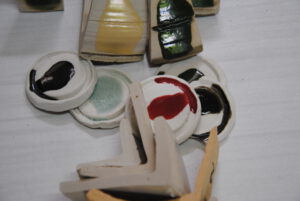Glazing is one of the cornerstones of ceramics. A bad glaze and it’s all wrong
For my part, I chose to glaze only the inside of my pieces, preferring to leave raw and soft porcelain for the outside.
All the glazes in the workshop are made by myself. I like these times of precise weighing. No doubt my past as a chemist is steel very present. Initially, a glaze contains silica and kaolin. However, a flux must be added so that the couple melts at a lower temperature. At high temperatures (1280 – 1300°C), the usual fluxes are potash, soda or magnesium. For earthenware, it is more difficult to lower the temperature of the Kaolin silica pair, lead has been used a lot, very powerful. Now, more concerned about the health effects of the products, we are moving towards lead-free glaze.
To glaze, you can dip the ceramic in it. But for myself almost always spray. The glaze is suspended in water and does not dissolved. When applied to the porous ceramic, the ceramic adsorbs water and the powder remain on the ceramic. When fired, the fine powder melts like glass.

